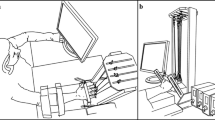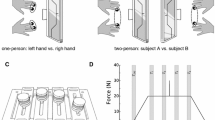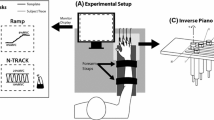Abstract
We tested a hypothesis that force production by multi-finger groups leads to lower indices of force variability as compared to similar single-finger tasks. Three experiments were performed with quick force production, steady-state force production under visual feedback, and steady-state force production without visual feedback. In all experiments, a range of force levels was used computed as percentages of the maximal voluntary contraction force for each involved finger combination. Force standard deviation increased linearly with force magnitude across all three experiments and all finger combinations. There were modest differences between multi-finger and single-finger tasks in the indices of force variability, significant only in the tasks with steady-state force production under visual feedback. When fingers acted in groups, each finger showed significantly higher force variability as compared to its single-finger task and as compared to the multi-finger group as a whole. Fingers that were not instructed to produce force also showed close to linear relations between force standard deviation and force magnitude. For these fingers, indices of force variability were much higher as compared to those computed for the forces produced by instructed fingers. We interpret the findings within a feed-forward scheme of multi-finger control with two inputs only one of which is related to the explicit task. The total force variability reflects variability in only the task-related component, while variability of the finger forces is also due to variability of the component that is not related to the task. The findings tentatively suggest that total force variability originates at an upper level of the control hierarchy in accordance to the Weber–Fechner law rather than reflects a “neural noise” at the segmental level.







Similar content being viewed by others
References
Bernstein NA (1967) The co-ordination and regulation of movements. Pergamon Press, Oxford
Carlton LG, Kim KH, Liu YT, Newell KM (1993) Impulse variability in isometric tasks. J Mot Behav 25:33–43
Christou EA, Grossman M, Carlton LG (2002) Modeling variability of force during isometric contractions of the quadriceps femoris. J Mot Behav 34:67–81
Christou EA, Zelent M, Carlton LG (2003) Force control is greater in the upper compared with the lower extremity. J Mot Behav 35:322–324
Danion F, Schöner G, Latash ML, Li S, Scholz JP, Zatsiorsky VM (2003) A force mode hypothesis for finger interaction during multi-finger force production tasks. Biol Cybern 88:91–98
Feldman AG, Levin MF (1995) Positional frames of reference in motor control: their origin and use. Behav Brain Sci 18:723–806
Feldman AG, Goussev V, Sangole A, Levin MF (2007) Threshold position control and the principle of minimal interaction in motor actions. Prog Brain Res 165:267–281
Gelfand IM, Tsetlin ML (1966) On mathematical modeling of the mechanisms of the central nervous system. In: Gelfand IM, Gurfinkel VS, Fomin SV, Tsetlin ML (eds) Models of the structural-functional organization of certain biological systems, pp 9–26, Nauka, Moscow (in Russian, a translation is available in 1971 edition by MIT Press: Cambridge MA)
Gibson JJ (1979) The ecological approach to visual perception. Houhgton Mifflin, Boston
Goodman SR, Latash ML (2006) Feedforward control of a redundant motor system. Biol Cybern 95:271–280
Goodman SR, Shim JK, Zatsiorsky VM, Latash ML (2005) Motor variability within a multi-effector system: Experimental and analytical studies of multi-finger production of quick force pulses. Exp Brain Res 163:75–85
Gorniak S, Duarte M, Latash ML (2008) Do synergies improve accuracy? A study of speed-accuracy trade-offs during finger force production. Motor Control 12:151–172
Gorniak S, Zatsiorsky VM, Latash ML (2007) Hierarchies of synergies: an example of the two-hand, multi-finger tasks. Exp Brain Res 179:167–180
Harris CM, Wolpert DM (1998) Signal-dependent noise determines motor planning. Nature 394:780–784
Johnson KO, Hsiao SS, Yoshioka T (2002) Neural coding and the basic law of psychophysics. Neuroscientist 8:111–121
Jones KE, Hamilton AF, Wolpert DM (2002) Sources of signal-dependent noise during isometric force production. J Neurophysiol 88:1533–1544
Kim SW, Shim JK, Zatsiorsky VM, Latash ML (2008) Finger interdependence: Linking the kinetic and kinematic variables. Hum Move Sci (in press)
Kunimoto C, Miller J, Pashler H (2001) Confidence and accuracy of near-threshold discrimination responses. Conscious Cogn 10:294–340
Latash ML (2008) Synergy. Oxford University Press, NY
Latash ML, Scholz JF, Danion F, Schöner G (2001) Structure of motor variability in marginally redundant multi-finger force production tasks. Exp Brain Res 141:153–165
Latash ML, Scholz JF, Danion F, Schöner G (2002a) Finger coordination during discrete and oscillatory force production tasks. Exp Brain Res 146:412–432
Latash ML, Scholz JP, Schöner G. (2002b) Motor control strategies revealed in the structure of motor variability. Exerc Sport Sci Rev 30:26–31
Latash ML, Scholz JP, Schöner G (2007) Toward a new theory of motor synergies. Motor Control 11:275–307
Latash ML, Shim JK, Smilga AV, Zatsiorsky VM (2005) A central back-coupling hypothesis on the organization of motor synergies: a physical metaphor and a neural model. Biol Cybern 92:186–191
Li ZM, Latash ML, Zatsiorsky VM (1998) Force sharing among fingers as a model of the redundancy problem. Exp Brain Res 119:276–286
Martin V, Scholz JP, Schöner G (2004) Theory of the uncontrolled manifold: variance, self-motion, and neuronal noise. Program No. 871.17. Abstract Viewer and Itinerary Planner. Washington, DC: Society for Neuroscience
Moritz CT, Barry BK, Pascoe MA, Enoka RM (2005a) Discharge rate variability influences the variation in force fluctuations across the working range of a hand muscle. J Neurophysiol 93:2449–2459
Moritz CT, Christou EA, Meyer FG, Enoka RM (2005b) Coherence at 16–32 Hz can be caused by short-term synchrony of motor units. J Neurophysiol 94:105–118
Newell KM, Carlton LG (1993) Force variability in isometric responses. J Exp Psychol: Hum Percep Perform 14:37–44
Ohtsuki T (1981) Inhibition of individual fingers during grip strength exertion. Ergonomics 24:21–36
Olafsdottir H, Yoshida N, Zatsiorsky VM, Latash ML (2005) Anticipatory covariation of finger forces during self-paced and reaction time force production. Neurosci Lett 381:92–96
Pilon J-F, De Serres SJ, Feldman AG (2007) Threshold position control of arm movement with anticipatory increase in grip force. Exp Brain Res 181:49–67
Scholz JP, Schöner G (1999) The uncontrolled manifold concept: Identifying control variables for a functional task. Exp Brain Res 126:289–306
Scholz JP, Danion F, Latash ML, Schöner G (2002) Understanding finger coordination through analysis of the structure of force variability. Biol Cybern 86:29–39
Shim JK, Olafsdottir H, Zatsiorsky VM, Latash ML (2005) The emergence and disappearance of multi-digit synergies during force production tasks. Exp Brain Res 164:260–270
Slifkin AB, Newell KM (1999) Noise, information transmission, and force variability. J Exp Psychol Hum Percept Perform 25:837–851
Slifkin AB, Newell KM (2000) Variability and noise in continuous force production. J Mot Behav 32:141–150
Sosnoff JJ, Jordan K, Newell KM (2005) Information and force level interact in regulating force output during two and three digit grip configurations. Exp Brain Res 167:76–85
Todorov E, Jordan MI (2002) Optimal feedback control as a theory of motor coordination. Nat Neurosci 5:1226–1235
Turvey MT (2007) Action and perception at the level of synergies. Hum Mov Sci 26:657–697
Vaillancourt DE, Slifkin AB, Newell KM (2002) Inter-digit individuation and force variability in the precision grip of young, elderly, and Parkinson’s disease participants. Motor Control 6:113–128
Zatsiorsky VM, Li ZM, Latash ML (1998) Coordinated force production in multi-finger tasks: Finger interaction and neural network modeling. Biol Cybern 79:139–150
Zatsiorsky VM, Li ZM, Latash ML (2000) Enslaving effects in multi-finger force production. Exp Brain Res 131:187–195
Zhang W, Scholz JP, Zatsiorsky VM, Latash ML (2008) What do synergies do? Effects of secondary constraints on multi-digit synergies in accurate force-production tasks. J Neurophysiol 99:500–513
Acknowledgments
The study was in part supported by NIH grants AG-018751, NS-035032, and AR-048563. We are grateful to Wei Zhang, Thomas Robert, Alexander Terekhov, Jason Friedman, and consultants from the Department of Statistics at Penn State University for their help at different stages of this project.
Author information
Authors and Affiliations
Corresponding author
Rights and permissions
About this article
Cite this article
Shapkova, E.Y., Shapkova, A.L., Goodman, S.R. et al. Do synergies decrease force variability? A study of single-finger and multi-finger force production. Exp Brain Res 188, 411–425 (2008). https://doi.org/10.1007/s00221-008-1371-3
Received:
Accepted:
Published:
Issue Date:
DOI: https://doi.org/10.1007/s00221-008-1371-3




